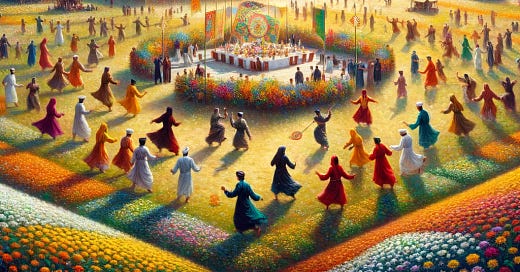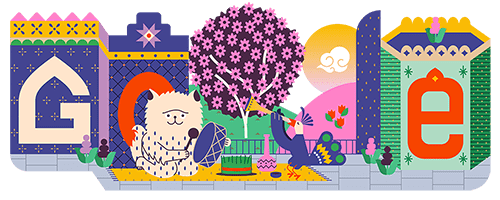Nowruz Mubarak: A Festival of Renewal and Harmony
Nowruz, Parsis and Zoroastrian Religion in the Indian context.
The Zoroastrian New Year: A Timeless Tradition
Nowruz, which literally means "new day," is the venerable festival that marks the Persian (Parsis) New Year, and this year, it graces us on March 19th, closely aligning with the vernal equinox. This ancient celebration, deeply rooted in the Zoroastrian religion, heralds the arrival of spring, symbolizing renewal, rebirth, and the rejuvenation of nature. Originating over 3,000 years ago in the cradle of ancient Persia, Nowruz transcends the boundaries of time and geography, embodying themes of renewal, health, and prosperity that resonate with humanity's enduring aspirations.
The Global Spread and Cultural Significance of Nowruz
As Nowruz traverses boundaries beyond its Zoroastrian and Persian origins, it has become a global celebration, embraced by diverse communities across the world. This widespread adoption underscores the festival's universal themes of renewal, unity, and the triumph of light over darkness. In each locale, Nowruz takes on unique cultural expressions while maintaining its core essence. For instance, in Afghanistan, the festival is marked by special dishes like Haft Mewa, a fruit salad made from seven different fruits, symbolizing the coming together of families and communities in celebration of the new year. Similarly, in the Kurdish regions, Nowruz is associated with the lighting of fires, signifying rebirth and the dispelling of the old year's hardships.
UNESCO’s Intangible Cultural Heritage
The inclusion of Nowruz in UNESCO's Representative List of the Intangible Cultural Heritage of Humanity in 2009 further solidified its status as a cultural practice of global importance. This recognition highlights the role of Nowruz in fostering social cohesion, friendship, and an understanding across cultures, transcending linguistic, religious, and national divides. The festival's emphasis on nature's renewal aligns with contemporary concerns regarding environmental sustainability and the need for harmony between humanity and the natural world.
Zoroastrian Heritage and Beyond
Moreover, the celebration of Nowruz serves as a testament to the enduring influence of the ancient Zoroastrian religion on modern customs and festivities. By promoting values such as peace, solidarity, and respect for the environment, Nowruz reflects the timeless relevance of these principles in guiding human coexistence and the stewardship of our planet. In an era marked by rapid changes and global challenges, Nowruz reminds us of the enduring power of cultural traditions to unite us in our common humanity, encouraging reflection, rejuvenation, and a hopeful outlook towards the future.
Zoroastrianism in India: The Parsi Legacy
The Zoroastrian faith, founded by the prophet Zarathustra (or Zoroaster), emphasizes the duality of good and evil, advocating for a life led by good thoughts, good words, and good deeds. The migration of Zoroastrians to India, following the Arab conquest of Persia, led to the establishment of the Parsi community, which has since become an integral part of the Indian societal fabric. Settling primarily in Gujarat and later spreading to Mumbai and other regions, Parsis have preserved their unique heritage and religious practices, including the celebration of Nowruz, within the diverse tapestry of Indian cultures.
Observance of Nowruz Among Indian Parsis
In India, the Parsi community observes Nowruz with great reverence and festivity, infusing it with their own traditions and customs. The preparation for the festival involves thorough house cleaning, or 'spring cleaning,' symbolizing the purging of old energies and making way for new beginnings. Central to the Nowruz celebrations is the setting of the Haft-Seen table, adorned with seven items starting with the letter 'S' in Persian, each symbolizing a specific virtue or wish for the new year.
Parsi families in India gather to share festive meals, which often include delicacies like Pulao-Dal (rice with lentils) and Patra ni Machhi (fish wrapped in banana leaves), reflecting the community's culinary heritage and the spirit of renewal embodied by Nowruz. The day is also marked by visits to fire temples, where prayers are offered, underscoring the Zoroastrian reverence for fire as a symbol of purity and light.
Eminent Parsis and Their Contributions to India
The Parsi community, though small in numbers, has made significant contributions to India's development across various fields. Eminent Parsis such as Jamshedji Tata, the pioneer industrialist who laid the foundation of the Tata Group, and Homi Bhabha, the father of India's nuclear science program, have left indelible marks on the nation's industrial and scientific landscape. The legacy of Parsis in philanthropy, arts, and public service further illustrates their integral role in shaping the ethos of modern India.
A Global Message of Peace and Harmony
Nowruz transcends its cultural and religious origins to offer a universal message of peace, solidarity, and renewal to the world. Its recognition by the United Nations as an international holiday underscores the importance of preserving cultural heritage and fostering mutual respect and dialogue among civilizations. In a world often divided by differences, Nowruz serves as a reminder of our common humanity and the shared aspirations that unite us across cultures and religions.
As we celebrate Nowruz today, let us reflect on its profound symbolism and the enduring legacy of the Zoroastrian faith, which, like Hinduism, dates back thousands of years before the Christian era. In the spirit of Nowruz, may we embrace the principles of renewal, kindness, and unity, fostering a global culture of peace and harmony that transcends geographical and cultural boundaries.






